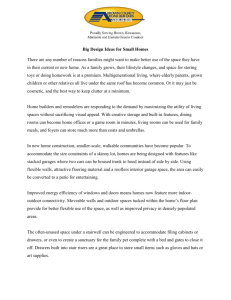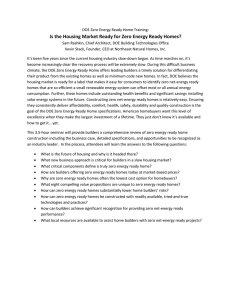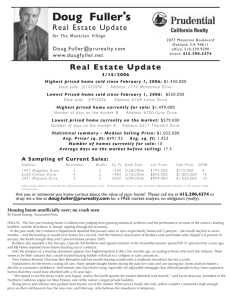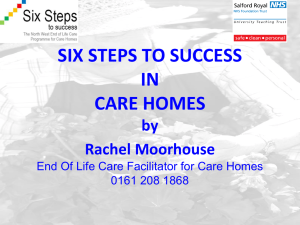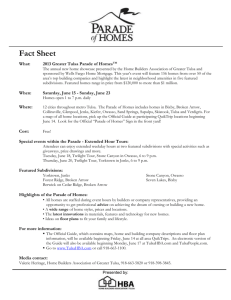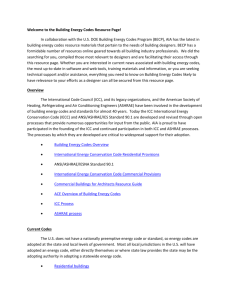Consumer Engagement in Energy Codes
advertisement
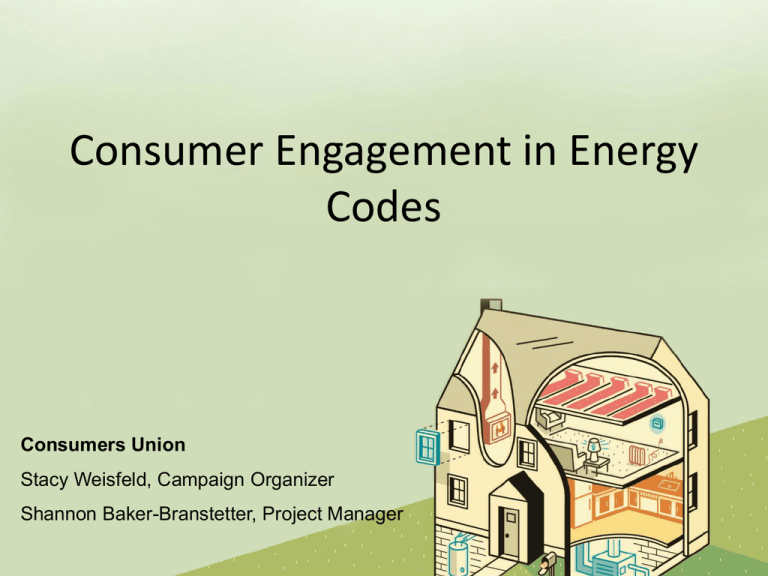
Consumer Engagement in Energy Codes Consumers Union Stacy Weisfeld, Campaign Organizer Shannon Baker-Branstetter, Project Manager What are energy codes? Minimum standards for energy efficiency in new and renovated residential and commercial buildings. Dan • Energy performance baseline • Part of overall building code adopted by state and local governments Examples of Energy Code Criteria Wood-burning fireplaces must have gasketed doors A home with a forcedair furnace heating system must have a programmable thermostat The IECC requires builders to post an IECC certificate near the electrical distribution box. International Energy Conservation Code (IECC) • National standard that Consumers Union references • Updated every 3 years • 2012 is most current Why Are Energy Codes Important? •Reduce energy consumption and greenhouse gas emissions •Save consumers $ •Stimulate the economy and create green jobs •Ensure health and safety •Improve long term sustainability Reduce energy consumption and greenhouse gas emissions • 1/3 of total US greenhouse gas emissions from building sector • 2012 IECC improves efficiency by 40% over 2003 code. Save consumers $ • Average U.S. home spends $2,175 on utility costs per year over $180 per month! • $800 more to build to 2009 code but payback with a 30 year mortgage is less than a year! • Average household saves $200 a year in energy costs Smart Investment Arvind Balaraman •Costs up to 5-times more to repair energy leaks and inefficiencies after the fact • Average cost of retrofitting homes is $4,800, compared to $800 to build it correctly from the start Help stimulate the economy and create green jobs • Local businesses and labor to create efficient products and better insulate homes • Ease pressure on organizations that help families with their energy costs • Alleviate demand to electrical grid and reduce need for new power plants Ensure health and safety • Well built and more comfortable homes • Consistent temperature in home • Fewer drafts • More Americans can stay cool in the summer and warm in the winter Simon Howden Resistance to Energy Codes • Confidence in current practice, business-asusual • Lack of information on quantity of energy wasted • Lack of enforcement • Unsure of costs/benefits The Importance of Consumer Outreach Why target consumers? • Consumers can eliminate our biggest barrier – opposition from home builders. • It’s hard to make policy changes without public support. • In communities where public support is high, energy codes are easier to adopt. • So… HOW to educate consumers? • THE FIRST STEP: Find out what motivates them. BCAP & Consumers Union – conducted a survey to consumers • PART 1: What messages resonate with consumers? 1.Money saving? 2.Environmental impacts? 3.Quality construction? 4.General benefits? 5.Common arguments against energy codes? Statement Prior to Survey Energy codes are minimum requirements that builders must meet to ensure that homes meet energy efficiency standards. Consumers agreed with the following statements: • Homebuilders should not make less efficient homes at the consumers’ expense (73%) • Energy codes would help my energy bills be more affordable and predictable (71%) • Energy codes help make homes more comfortable to live in (68%) • Energy code standards will help to ensure quality home construction(70%) Consumers agreed with the following statements: • Energy codes should be enforced like other safety and quality standards of construction (75%) • Homeowners should have a right to a home that meets national energy standards (82%) • Energy code standards will help ensure that homeowner and taxpayer dollars are used wisely and efficiently as new building will be required to be built right the first time (74%) • I would rather pay slightly more for a new home and have affordable, predictable operating costs and energy bills (79%) Used Findings to Develop Resources for Consumers, Advocates and Professionals 1. 2. 3. 4. 5. 6. 7. Consumer Guide Home Guide Home Checklist Advocate Guide Consumer Handout Professional Handout Realtor Handout Consumers Union Outreach Consumers Union Outreach Share Your Story Feature How Partners Can Get Involved • Collaborate on information development • Collaborate on dissemination of materials – events, meetings, newsletters, websites, listservs • Educate members and the community at large • How to reach new homeowners/communities with new buildings – point of sale, lit drop in newly built communities, city hall meetings? • Other? Questions? Contact information: Stacy Weisfeld, Campaign Organizer sweisfeld@consumer.org, 202-462-6262 Shannon Baker-Branstetter, Project Manager bakesh@consumer.org, 202-462-6262 Thanks to our partners at BCAP, Kelly Guhanick, Maureen Guttman and Maria Ellingson.

